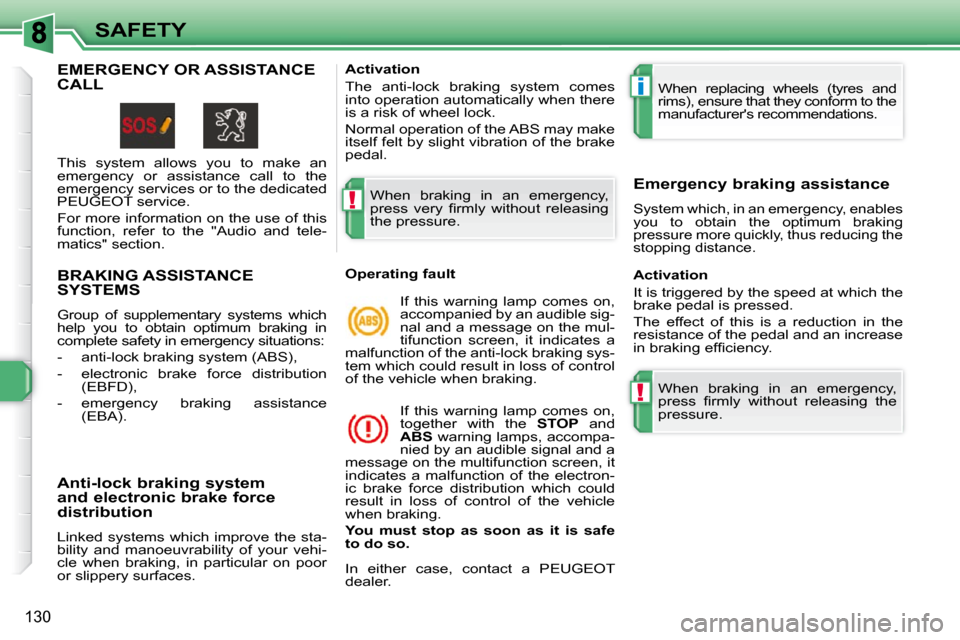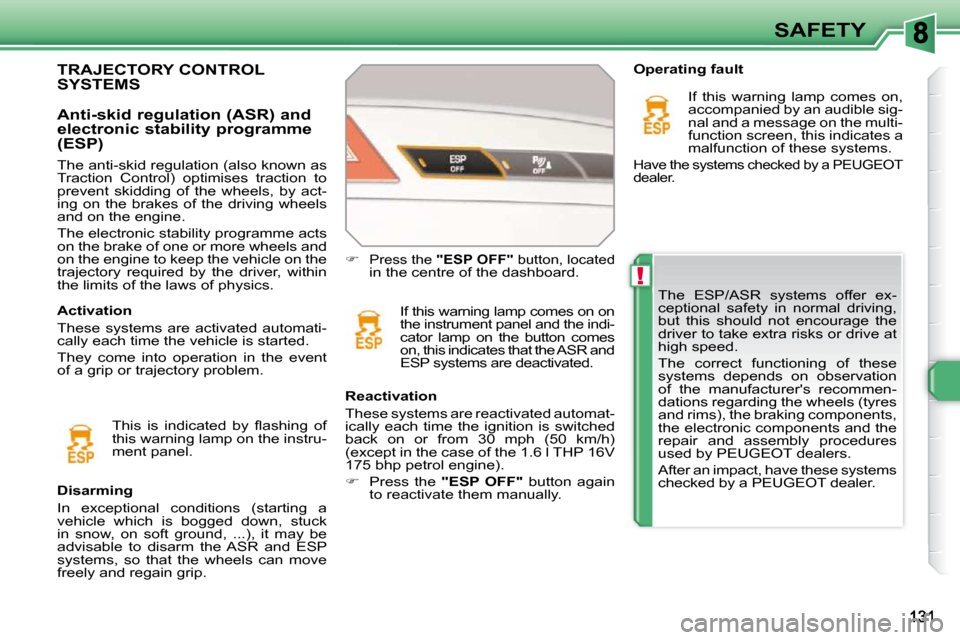2009.5 Peugeot 308 SW BL Dag rims
[x] Cancel search: rimsPage 126 of 313

!
i
!
130
SAFETY
BRAKING ASSISTANCE SYSTEMS
Group of supplementary systems which
help you to obtain optimum braking in
complete safety in emergency situations:
- anti-lock braking system (ABS),
- electronic brake force distribution (EBFD),
- emergency braking assistance (EBA).
Anti-lock braking system
and electronic brake force
distribution
Linked systems which improve the sta-
bility and manoeuvrability of your vehi-
cle when braking, in particular on poor
or slippery surfaces. When braking in an emergency,
�p�r�e�s�s� �v�e�r�y� �fi� �r�m�l�y� �w�i�t�h�o�u�t� �r�e�l�e�a�s�i�n�g�
the pressure.
When replacing wheels (tyres and
rims), ensure that they conform to the
manufacturer's recommendations.
Operating fault If this warning lamp comes on,
accompanied by an audible sig-
nal and a message on the mul-
tifunction screen, it indicates a
malfunction of the anti-lock braking sys-
tem which could result in loss of control
of the vehicle when braking.
If this warning lamp comes on,
together with the STOP and
ABS warning lamps, accompa-
nied by an audible signal and a
message on the multifunction screen, it
indicates a malfunction of the electron-
ic brake force distribution which could
result in loss of control of the vehicle
when braking.
You
must
stop as soon as it is safe
to do so. Emergency braking assistance
System which, in an emergency, enables
you to obtain the optimum braking
pressure more quickly, thus reducing the
stopping distance.
Activation
The anti-lock braking system comes
into operation automatically when there
is a risk of wheel lock.
Normal operation of the ABS may make
itself felt by slight vibration of the brake
pedal.
Activation
It is triggered by the speed at which the
brake pedal is pressed.
The effect of this is a reduction in the
resistance of the pedal and an increase
�i�n� �b�r�a�k�i�n�g� �e�f�fi� �c�i�e�n�c�y�.�
In either case, contact a PEUGEOT
dealer. When braking in an emergency,
�p�r�e�s�s� �fi� �r�m�l�y� �w�i�t�h�o�u�t� �r�e�l�e�a�s�i�n�g� �t�h�e�
pressure. EMERGENCY OR ASSISTANCE CALL
This system allows you to make an
emergency or assistance call to the
emergency services or to the dedicated
PEUGEOT service.
For more information on the use of this
function, refer to the "Audio and tele-
matics" section.
Page 127 of 313

!
SAFETY
The ESP/ASR systems offer ex-
ceptional safety in normal driving,
but this should not encourage the
driver to take extra risks or drive at
high speed.
The correct functioning of these
systems depends on observation
of the manufacturer's recommen-
dations regarding the wheels (tyres
and rims), the braking components,
the electronic components and the
repair and assembly procedures
used by PEUGEOT dealers.
After an impact, have these systems
checked by a PEUGEOT dealer.
Disarming
In exceptional conditions (starting a
vehicle which is bogged down, stuck
in snow, on soft ground, ...), it may be
advisable to disarm the ASR and ESP
systems, so that the wheels can move
freely and regain grip.
�
Press the "ESP OFF" button, located
in the centre of the dashboard.
If this warning lamp comes on on
the instrument panel and the indi-
cator lamp on the button comes
on, this indicates that the ASR and
ESP systems are deactivated.
Reactivation
These systems are reactivated automat-
ically each time the ignition is switched
back on or from 30 mph (50 km/h)
(except in the case of the 1.6 l THP 16V
175 bhp petrol engine).
� Press the "ESP OFF" button again
to reactivate them manually. Operating fault
If this warning lamp comes on,
accompanied by an audible sig-
nal and a message on the multi-
function screen, this indicates a
malfunction of these systems.
Have the systems checked by a PEUGEOT
dealer.
TRAJECTORY CONTROL SYSTEMS
Activation
These systems are activated automati-
cally each time the vehicle is started.
They come into operation in the event
of a grip or trajectory problem.
Anti-skid regulation (ASR) and
electronic stability programme
(ESP)
� �T�h�i�s� �i�s� �i�n�d�i�c�a�t�e�d� �b�y� �fl� �a�s�h�i�n�g� �o�f�
this warning lamp on the instru-
ment panel.
The anti-skid regulation (also known as
Traction Control) optimises traction to
prevent skidding of the wheels, by act-
ing on the brakes of the driving wheels
and on the engine.
The electronic stability programme acts
on the brake of one or more wheels and
on the engine to keep the vehicle on the
trajectory required by the driver, within
the limits of the laws of physics.
Page 197 of 313

11
!
i
i
200
PRACTICAL INFORMATION� �T�h�e� �fi� �t�t�i�n�g� �o�f� �e�l�e�c�t�r�i�c�a�l� �e�q�u�i�p�m�e�n�t�
or accessories which are not rec-
ommended by PEUGEOT may
result in a failure of your vehicle's
electronic system.
� �P�l�e�a�s�e� �n�o�t�e� �t�h�i�s� �s�p�e�c�i�fi� �c� �w�a�r�n�i�n�g�.�
You are advised to contact a repre-
sentative of the Marque to be shown
the range of recommended equip-
ment and accessories.
Depending on the country in which
the vehicle is sold, it is compulsory
to have a high visibilty jacket, warn-
ing triangle and spare bulbs avail-
able in the vehicle.
"Styling":
"Universal":
You can obtain "Van" conversion kits to
transform a private vehicle into a van. seat covers compatible with lat-
eral airbags, aluminium gear le-
�v�e�r� �k�n�o�b�,� �f�o�g�l�a�m�p�s�,� �s�u�n�r�o�o�f� �*�*�*� �,�
�d�o�o�r� �d�e�fl� �e�c�t�o�r�s�,� �s�p�o�i�l�e�r�,� �s�t�y�l�i�n�g�
strips, alloy wheels, trims, sport
�e�x�h�a�u�s�t�,� �b�o�d�y� �k�i�t�.� �
� �s�c�r�e�e�n�w�a�s�h�,� �i�n�t�e�r�i�o�r� �a�n�d� �e�x�t�e�-
rior maintenance and cleaning
products.
� � �*�*�*� � � � �S�u�n�r�o�o�f� �w�h�i�c�h� �m�u�s�t� �b�e� �fi� �t�t�e�d� �b�y� �t�h�e� PEUGEOT network.
"In-car technology":
audio systems, audio/tele-
�p�h�o�n�e�,� �a�m�p�l�i�fi� �e�r�s�,� �s�a�t�e�l�l�i�t�e�
�n�a�v�i�g�a�t�i�o�n� �s�y�s�t�e�m�s�,� �B�l�u�e�t�o�o�t�h�
system, CD changer, speak-
ers, DVD player, connection
kit for MP3 player or portable
�C�D� �p�l�a�y�e�r�,� �U�S�B� �B�o�x�,� �r�e�a�r�
parking sensors.
Installation of
radiocommunication
transmitters
It is advisable to contact a repre-
sentative of the PEUGEOT marque
before installing accessory radio-
communication transmitters with
�a�n� �e�x�t�e�r�n�a�l� �a�e�r�i�a�l� �o�n� �y�o�u�r� �v�e�h�i�c�l�e�.�
The PEUGEOT network will pro-
�v�i�d�e� �y�o�u� �w�i�t�h� �t�h�e� �s�p�e�c�i�fi� �c�a�t�i�o�n�s�
�(�f�r�e�q�u�e�n�c�y� �b�a�n�d�,� �m�a�x�i�m�u�m� �o�u�t�-
put power, aerial position, spe-
�c�i�a�l� �i�n�s�t�a�l�l�a�t�i�o�n� �c�o�n�d�i�t�i�o�n�s�)� �o�f� �t�h�e�
�t�r�a�n�s�m�i�t�t�e�r�s� �w�h�i�c�h� �c�a�n� �b�e� �fi� �t�t�e�d�,� �i�n�
accordance with the Vehicle Elec-
tromagnetic Compatibility Directive
�(�2�0�0�4�/�1�0�4�/�C�E�)�.� �